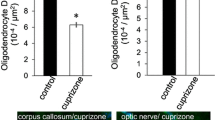Summary
We have studied remyelination of rat peripheral nerves after tellurium-induced demyelination using thin section and freeze-fracture techniques. In rats fed a 1% tellurium diet, regions of demyelination were readily identified by myelin debris and the presence of large denuded axons. Remyelination occurred despite continued tellurium ingestion. However, the demyelinated axons underwent a more rapid remyelination if tellurium was removed from the diet. Remyelination proceeded as described for myelination in the normal developing animal. Sites destined to become nodes of Ranvier were identified as patches of intramembranous particles in the axonal E-face. Early terminal loops of the remyelinating Schwann cell were found adjacent to these particle patches. As wrapping proceeded, terminal loops of myelin, along with associated rows of dimeric-particles characteristic of the axonal P-face, were wound into a paranodal location. This winding of the membrane specializations and associated terminal loops resulted in the reformation of morphologically normal paranodes. The size of the nodal E-face particle patch increased in concordance with increases in the number of paranodal loops until an annulus of particles was obtained as seen in the normal node. The thin section and freeze-fracture morphology of remyelinated fibres was indistinguishable from the morphology of control fibres. These observations are discussed with respect to proposed functions of membrane specializations in myelination and nerve conduction.
Similar content being viewed by others
References
Berthold, C. H. &Skoglund, S. (1968) Postnatal development of feline paranodal myelin-sheath segments II. Electron microscopy.Ada Sodetatis medicorum upsaliensis 73, 127–44.
Braheny, S. L. &Lampert, P. W. (1980) Tellurium. InExperimental and Clinical Neurotoxicology, (edited bySpencer, P. S. &Schaumburg, H.), pp. 558–69. Baltimore: Williams & Wilkins.
Carpenter, F. G. &Bergland, R. M. (1957) Excitation and conduction in immature nerve fibres of the developing chick.American Journal of Physiology 190, 371–6.
Duckett, S., Said, G., Streleta, L. G., White, R. G. &Galle, P. (1979) Tellurium-induced neuropathy: Correlative physiological, morphological and electron microprobe studies.Neuropathology and Applied Neurobiologe 5, 265–78.
Duckett, S. &White, R. (1974) Cerebral lipofuscinosis induced with tellurium: energy dispersive X-ray spectrophotometry analysis.Brain Research 73, 205–214.
Ellisman, M. H. &Staehelin, L. A. (1979) An electronically interlocked electron gun shutter for preparing improved replicas of freeze-fracture specimens. InPreparation Dependent Changes in Freeze-Fracture, (edited byRash, J. E. &Hudson, C. S.), pp. 123–125. New York: Raven Press.
Lampert, P. W. &Garrett, R. S. (1971) Mechanisms of demyelination in tellurium neuropathy: electron microscopic observations.Laboratory Investigation 25, 380–8.
Lampert, P., Garro, F. &Pentschew, A. (1970) Tellurium neuropathy.Acta Neuropathologica 15, 308–17.
Miyoshi, K. &Takauchi, S. (1977) Chronic tellurium intoxication in rats.Folia Psychiatrica et Neurologica Japonica 31, 111–8.
Mollenhauer, H. H. (1964) Plastic embedding mixtures for use in electron microscopy.Stain Technology 39, 111–4.
Smith, K. J. &Hall, S. M. (1981) Nerve conduction during peripheral demyelination and remyelination.Journal of the Neurological Sciences (in press).
Sumner, A., Pleasure, D. &Ciesielka, K. (1976) Slowing of fast axoplasmic transport in acrylamide neuropathy.Journal of Neuropathology and Experimental Neurology 35, 319a.
Wiley, C. A. &Ellisman, M. H. (1980) Rows of dimeric particles within the axolemma and juxtaposed particles within glia, incorporated into a new model for the paranodal glial-axonal junction at the node of Ranvier.Journal of Cell Biology 84, 261–80.
Wiley-Livingston, C. A. &Ellisman, M. H. (1980) Development of axonal membrane specializations defines nodes of Ranvier and precedes Schwann cell myelin elaboration.Developmental Biology 79, 334–55.
Wiley-Livingston, C. A. &Ellisman, M. H. (1981) Changes in membrane specialization at the node of Ranvier during tellurium-induced demyelination and remyelination.Society for Neurosciences 17, 306 (Abstract).
Author information
Authors and Affiliations
Rights and permissions
About this article
Cite this article
Wiley-Livingston, C.A., Ellisman, M.H. Return of axonal and glial membrane specializations during remyelination after tellurium-induced demyelination. J Neurocytol 11, 65–80 (1982). https://doi.org/10.1007/BF01258005
Received:
Revised:
Accepted:
Issue Date:
DOI: https://doi.org/10.1007/BF01258005




